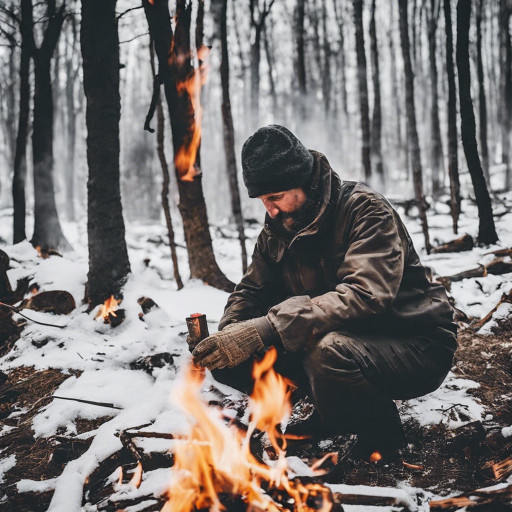Master Essential Fire Starting Techniques for Survival in Extreme Cold Weather
Starting a fire in freezing temperatures is not merely a survival skill; it is an essential element for enduring the harsh realities of winter. The biting chill and relentless winds of the cold season can be unforgiving, making the ability to generate heat a crucial factor in survival. As someone who values survival skills, you recognize that fire provides warmth, light, and a means to cook food—three lifelines when battling the elements. However, igniting a flame in icy conditions presents unique challenges that demand specialized techniques. In this comprehensive guide, we will delve into proven methods and strategies that will empower you to create and maintain a fire even in the most frigid environments, ensuring you can thrive rather than merely survive during winter’s chill.
Equip Yourself with Essential Fire-Starting Gear for Cold Weather Adventures
Prior to embarking on any winter outdoor expedition, it is imperative to prepare yourself with the right tools and supplies. A well-prepared fire-starting kit can make all the difference in overcoming the adversities posed by cold weather. To enhance your chances of successfully igniting a fire, be sure to include the following vital items in your kit:

a. Firestarters: Having reliable ignition tools is paramount for successful fire starting in challenging conditions. Invest in waterproof matches, storm-resistant lighters, and fire-starting rods. These tools ensure you can spark a fire regardless of wind or moisture, instilling confidence in your ability to create warmth and light when faced with cold weather challenges.
b. Dry Tinder: Finding dry tinder in frigid temperatures can be a formidable task. To combat this issue, make sure to pack highly flammable materials such as birch bark, fatwood shavings, and cotton balls soaked in petroleum jelly. These materials ignite rapidly, significantly boosting your chances of successfully starting a fire even when temperatures plunge below freezing.
c. Kindling: To build a strong foundation for your fire, gather an assortment of dry sticks, twigs, and leaves. It is vital that these materials are thoroughly dry, as any trace of moisture can obstruct the ignition process and lead to frustration. Properly prepared kindling is essential for transitioning from tinder to a more robust fire that can withstand the cold.
d. Fuel: Securing dry firewood can be both exhausting and time-consuming in frigid conditions. Therefore, it’s crucial to have a sufficient stock of dry firewood ready before you need it. This preparation ensures a steady flame that will keep you warm and allow you to cook food comfortably for extended periods.
Select the Optimal Location for Your Fire to Enhance Survival Efficiency
When temperatures drop, the location of your fire can greatly affect its efficiency and effectiveness. Look for sheltered spots, such as rock formations or thick brush, to minimize exposure to harsh winds. By positioning your fire in a natural windbreak, you can significantly reduce heat loss and improve the likelihood of maintaining a steady flame. Additionally, consider building a small wind-resistant shelter with logs or a tarp to protect your fire from precipitation and retain warmth, ultimately enhancing your safety and comfort in the wilderness.
Utilize the Layering Technique to Build Sustainable and Effective Fires
One of the most critical skills for successfully igniting a fire in cold conditions is mastering the layering technique. To create a fire that burns steadily and effectively, you must utilize three foundational layers: tinder, kindling, and fuel. Here’s a detailed breakdown of each layer and its critical role:
a. Tinder: The first layer, consisting of materials that ignite quickly, is crucial for a successful fire start. Utilize fine, dry materials such as grass, paper, or birch bark to create a robust initial flame. Ensuring you have an adequate supply of tinder is essential for achieving ignition, especially in cold, damp environments.
b. Kindling: This second layer comprises small sticks and twigs that catch fire quickly, providing sustained heat. Gradually add kindling to your flame, ensuring there is enough space between pieces to allow for airflow and promote combustion. This step is vital for transitioning from small flames to a larger, more stable fire that can resist the cold.
c. Fuel: Once a steady flame is established, begin introducing larger pieces of firewood. Ensure the wood is dry, as this will burn longer and generate more heat. Gradually increase the size of the wood pieces, allowing flames to grow stronger before adding larger logs. This strategic layering approach not only facilitates a stable flame but also ensures a sustainable fire that can withstand the elements.
The layering technique creates a structured setup, allowing flames to expand and sustain themselves effectively. Always make sure to have an adequate supply of each component available to ensure a smooth transition from tinder to fuel, which is crucial for achieving success in challenging conditions.
Enhance Your Fire-Starting Success with Proven Tips and Aids
In cold weather, utilizing additional fire-starting aids can significantly improve your chances of successfully igniting a fire despite the challenges presented by low temperatures. Consider these effective methods:
a. Fatwood: Often referred to as nature’s firestarter, fatwood is infused with resin and ignites easily, burning with intense heat. You can collect these naturally occurring sticks from fallen pine trees or purchase them from outdoor supply retailers. A few pieces of fatwood can drastically enhance your fire-starting efforts in especially cold conditions.
b. Alcohol-Based Hand Sanitizer: Surprisingly effective, alcohol-based hand sanitizer is highly flammable and can serve as an accelerant. A small amount applied to your tinder or kindling can help ignite a fire quickly, even in damp conditions, simplifying the fire-starting process and ensuring you remain warm when it matters most.
c. Char Cloth: Char cloth is a specially prepared fabric that ignites easily from sparks, making it a fantastic tool for starting fires using flint and steel or a lighter in difficult situations. Its lightweight and portable design makes it an ideal addition to your fire-starting kit, ensuring you are always prepared for any scenario.
Incorporating these fire-starting aids into your cold-weather toolkit can significantly enhance your ability to adapt and succeed in igniting a fire when conditions are particularly challenging.
Explore Effective Fire Techniques Specifically Designed for Cold Weather Survival
As a committed survivalist, continually refining your skills is essential for your success. Here are two fire techniques that stand out in cold weather scenarios:
a. Swedish Torch: Also known as a Canadian Candle or Finnish Fire Log, the Swedish Torch is an exceptionally efficient method for starting a fire. This technique offers a stable and long-lasting flame, ideal for combating the cold of winter. To create a Swedish Torch, select a log about knee-height and cut several vertical slits along its length. Fill the slits with tinder and ignite it. The log will act as a continuous fuel source, allowing the flame to endure for an extended period, ensuring warmth and safety during your outdoor adventures.
b. Dakota Fire Hole: When faced with strong winds, the Dakota Fire Hole technique proves to be highly effective. This method involves digging a hole and tunneling horizontally underground to create an airflow vent. This design utilizes wind to enhance airflow, resulting in a more efficient fire that is less likely to be disrupted by gusts. Additionally, the Dakota Fire Hole method minimizes visible smoke while conserving fuel, making it an excellent choice for discreet fire building in the wild.
Regardless of the technique you choose, always prioritize safety and responsible fire management to minimize risks and ensure a successful fire-starting experience in the wilderness.
Successfully igniting a fire in cold weather demands careful planning and execution. By following these strategies—preparing a reliable fire-starting kit, selecting an ideal location, mastering layering techniques, utilizing fire-starting aids, and embracing specific fire-building strategies—you will greatly improve your chances of success. Remember, practice is vital, so regularly train to refine your skills and boost your confidence. With these essential tactics for igniting fires in freezing conditions at your disposal, you’ll be well-equipped to face even the harshest winters nature has to offer. Stay warm, prioritize safety, and keep the flames of survival burning bright!
The post Fire Starting Methods for Survivalists in Cold Weather appeared first on Survival Bite.
The Article Fire Starting Techniques for Cold Weather Survival Was Found On https://limitsofstrategy.com


This article really resonates with me, especially as someone who actively seeks to enhance my outdoor survival skills. There’s something profoundly grounding about the ability to start a fire, particularly when faced with the unforgiving elements of winter. I recall a winter camping trip where my friend and I underestimated how challenging it could be to keep a fire going in sub-zero temperatures. We had the basics—matches, kindling, and logs—but the wind picked up, and the relentless cold made it nearly impossible to maintain heat. It was a hard lesson in the necessity of preparation and technique.
Your experience brings back memories of my own winter camping adventures, where the elements really put everything to the test. I remember one trip where the firewood we gathered was so damp that we practically spent the first half of the night trying to coax it to catch. It’s fascinating how something as simple as a fire can become a multi-layered challenge, especially in cold conditions.